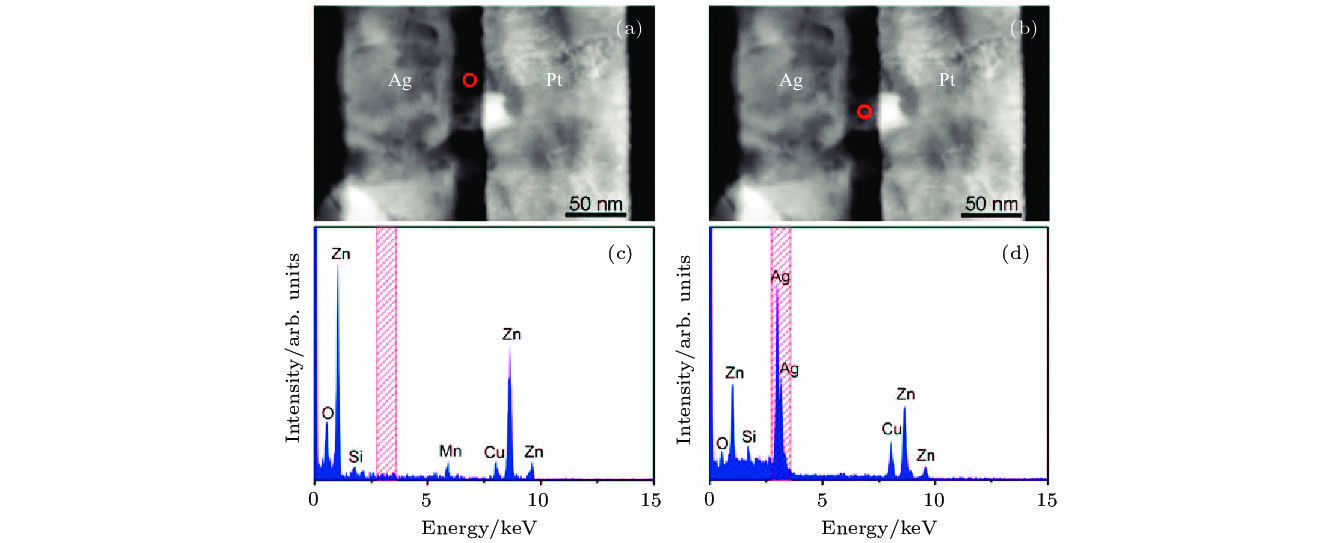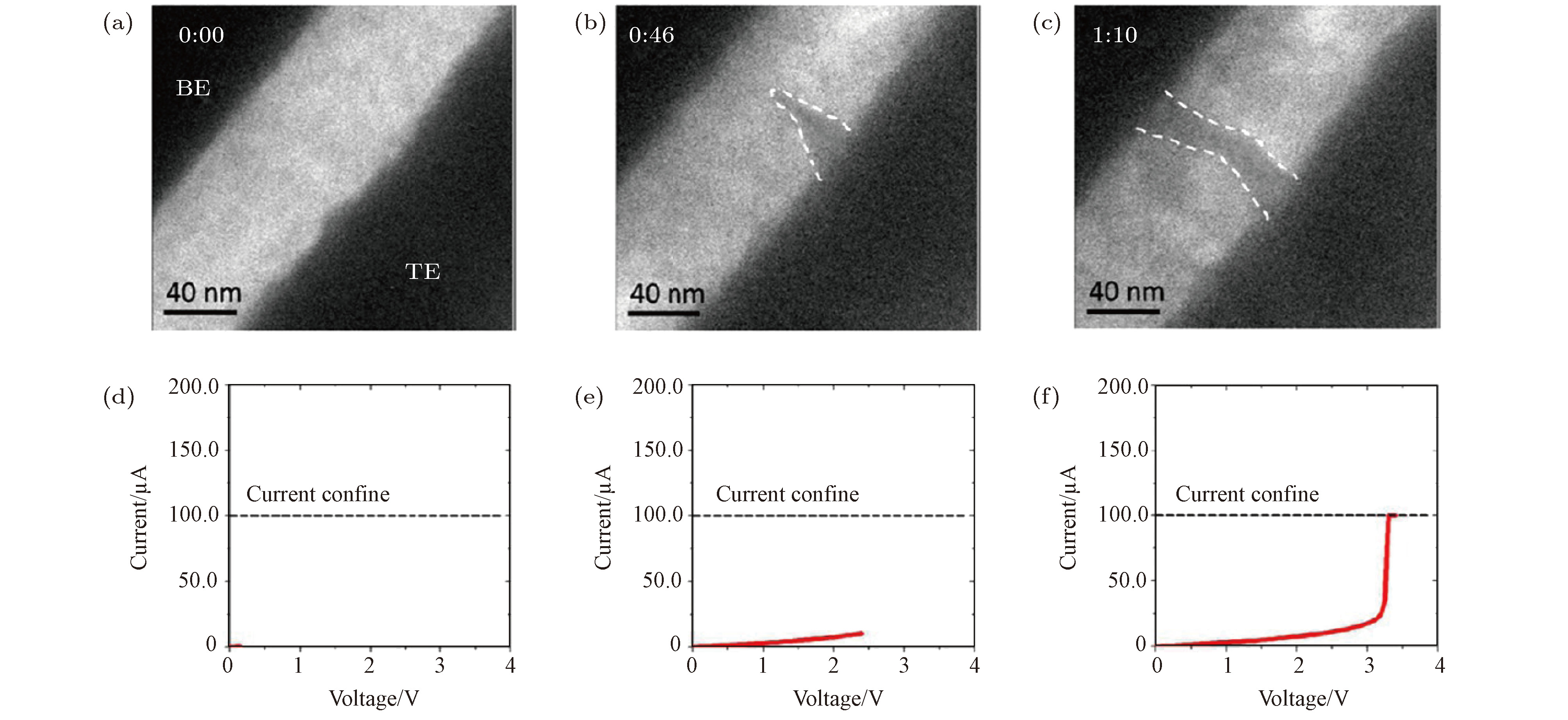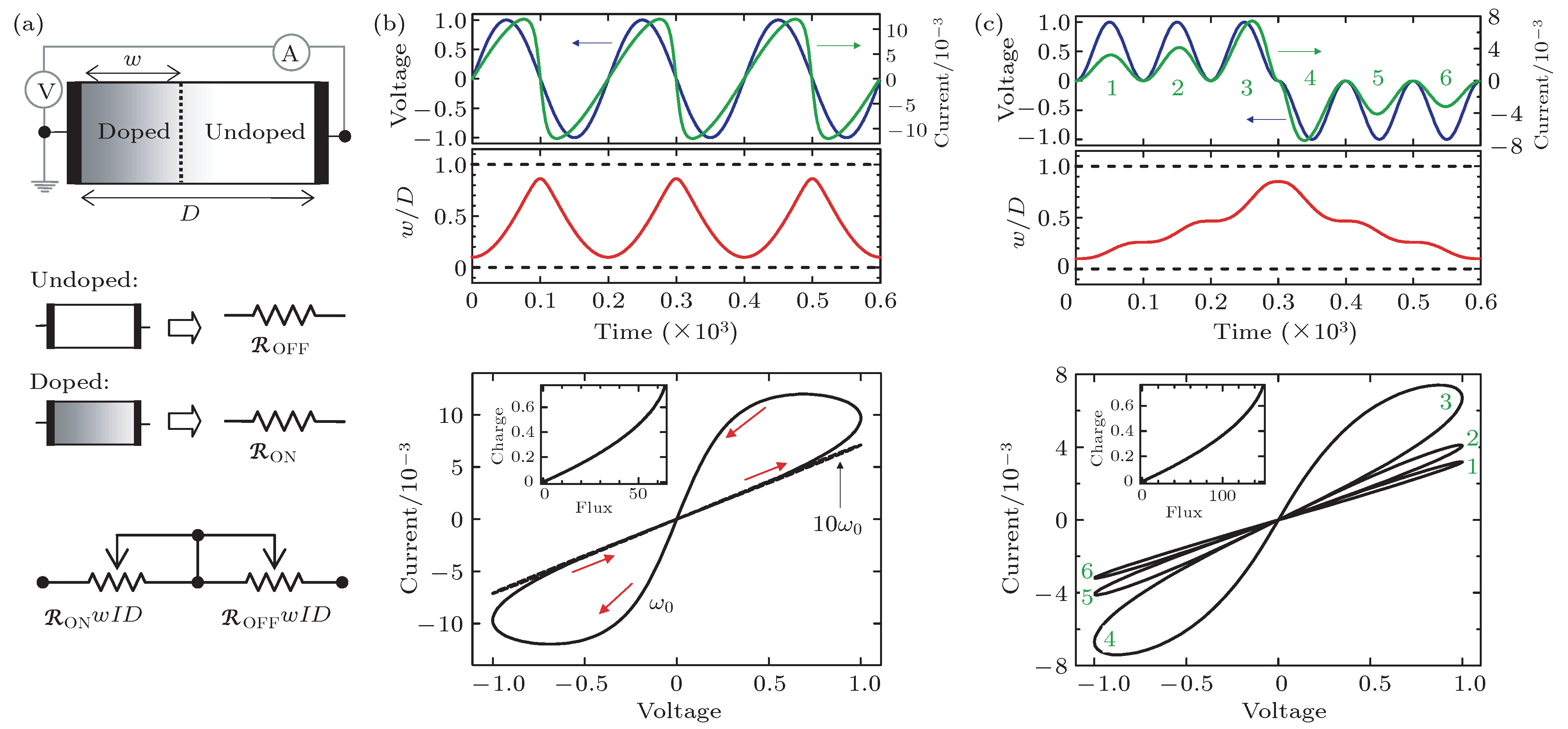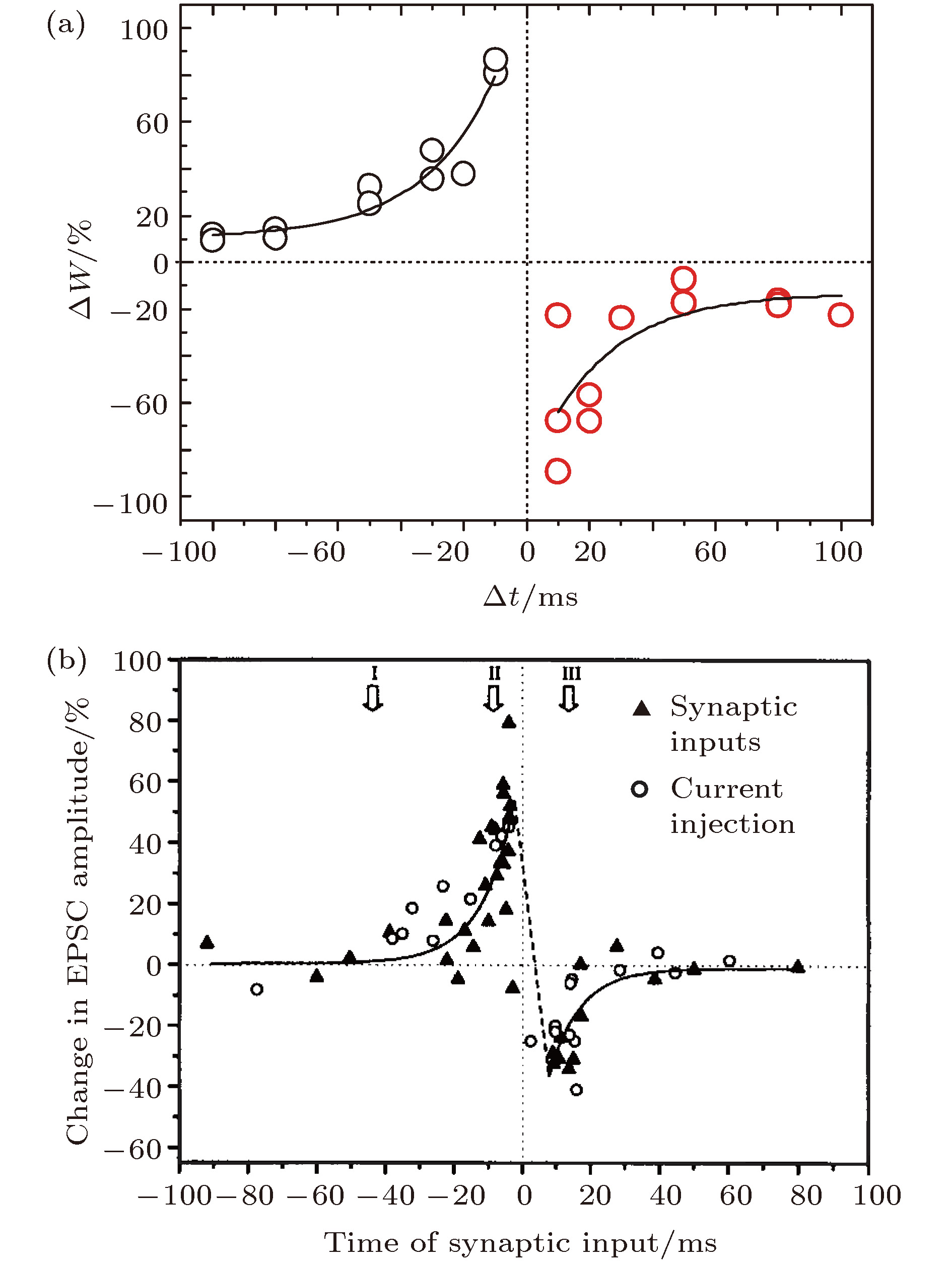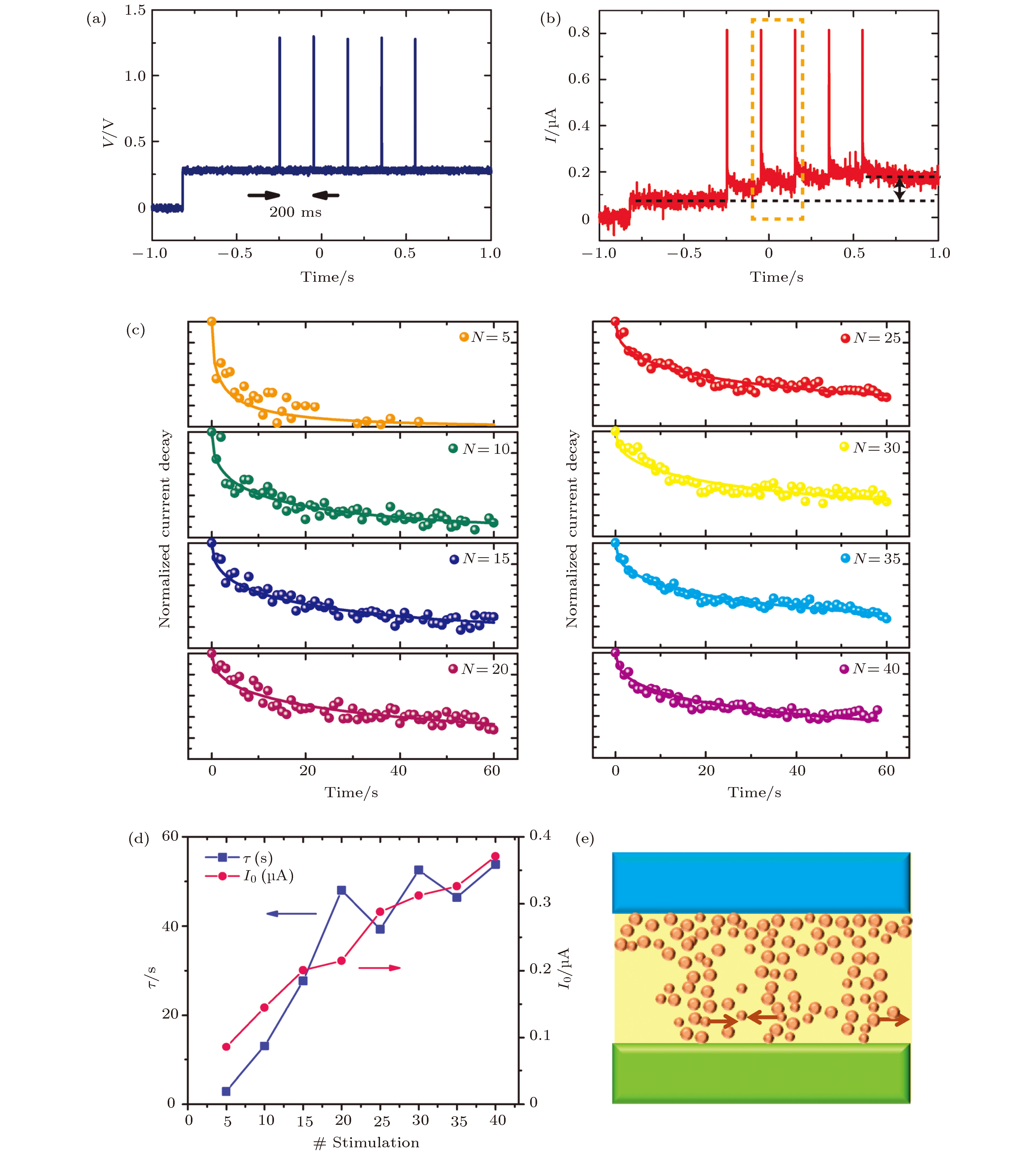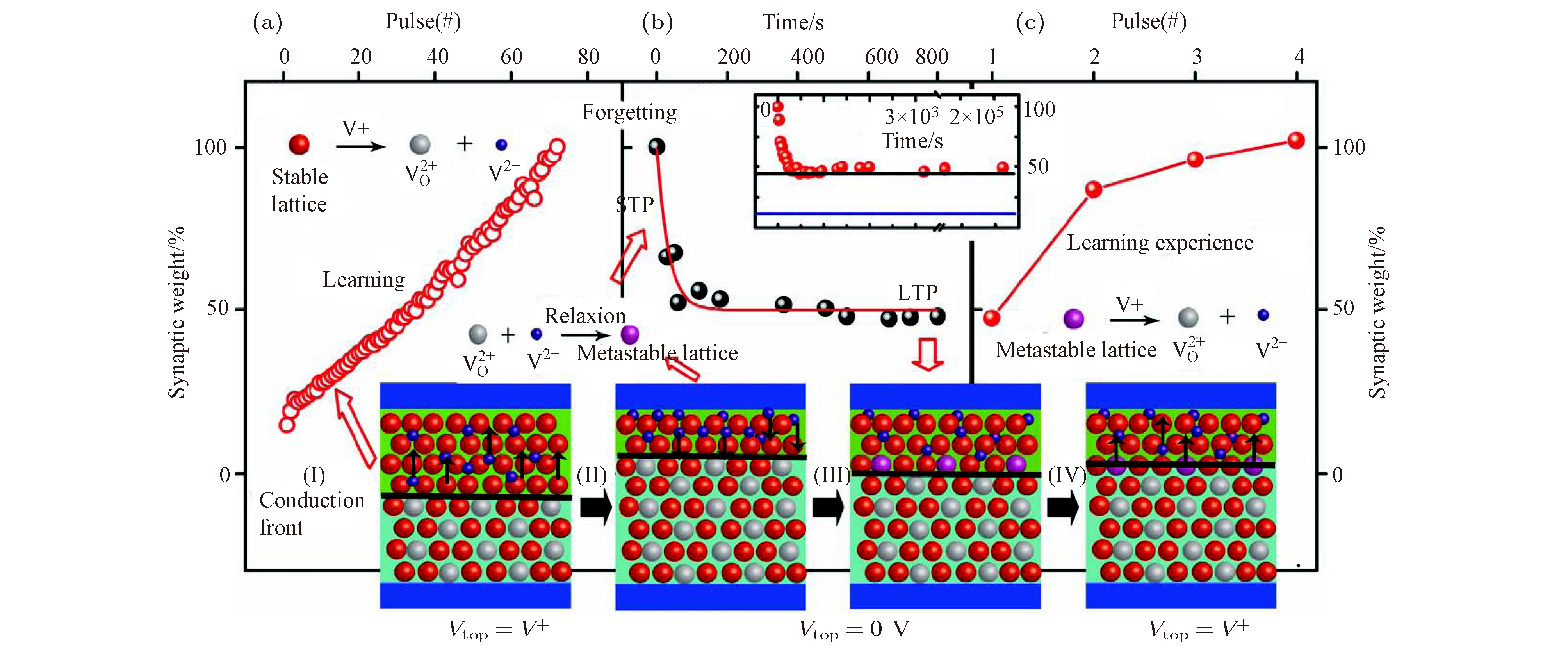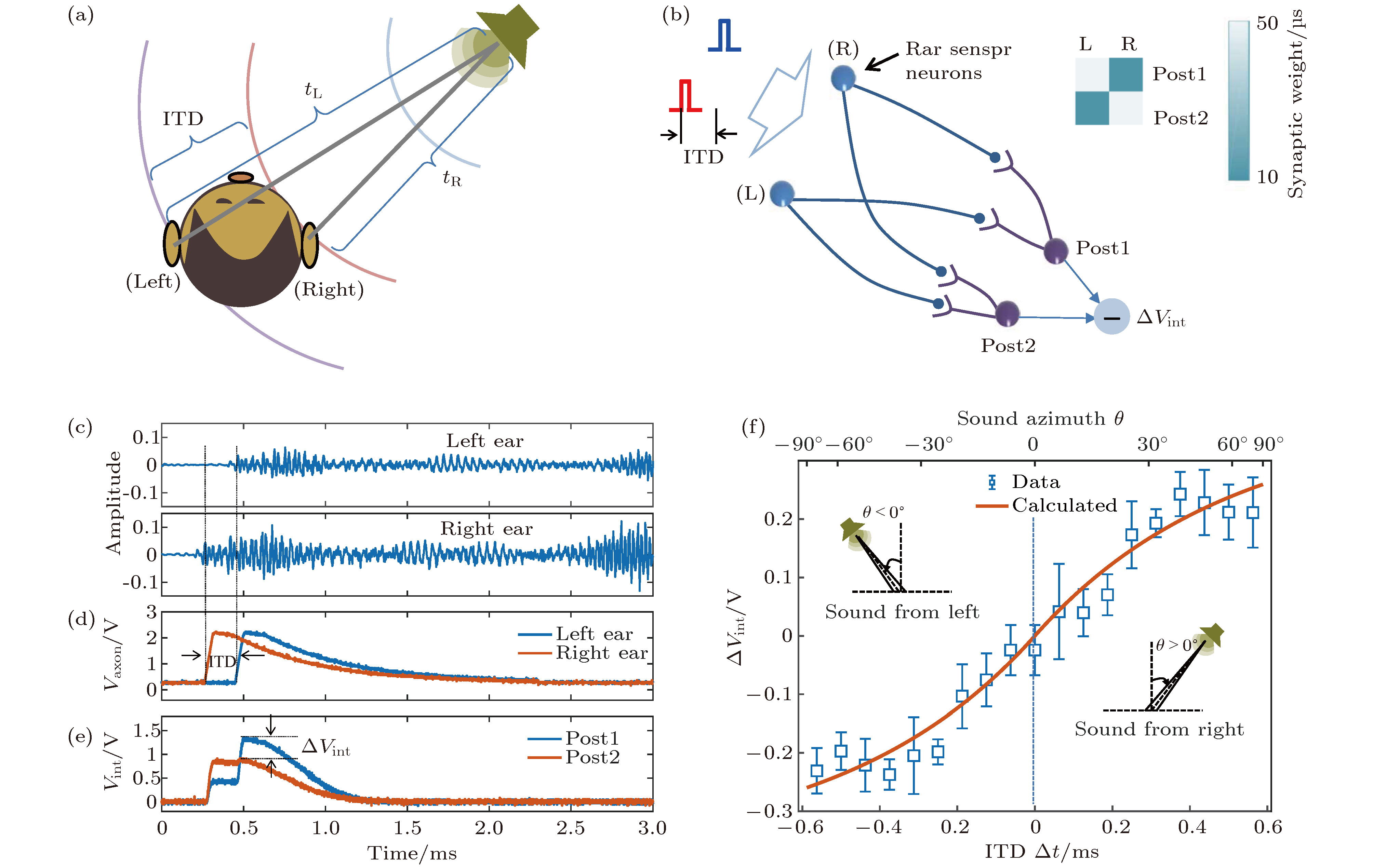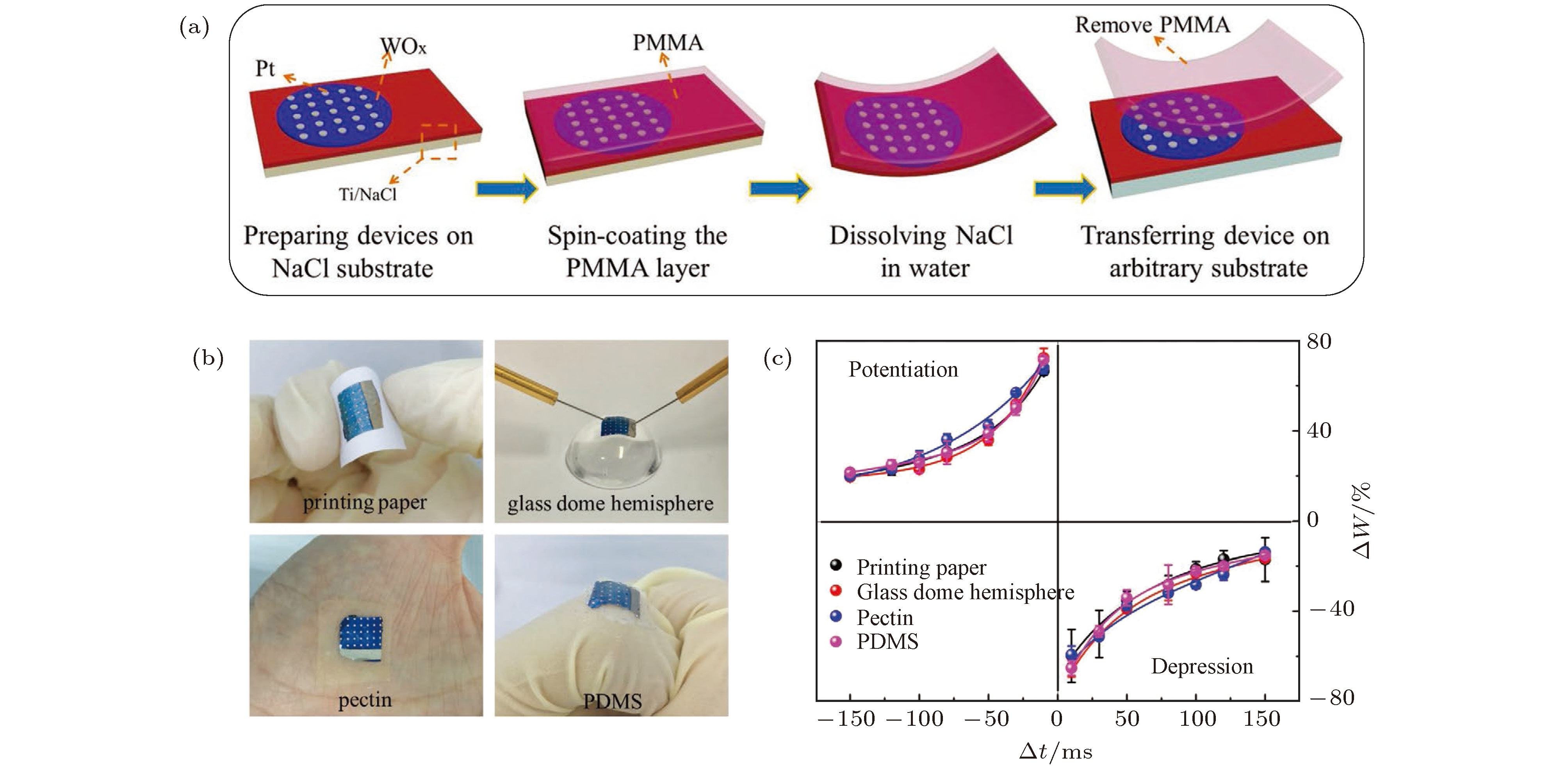-
Memristors are considered to be the potential candidate for simulating synapses due to their high density, low power consumption and continuously adjustable resistance. Metal oxide is an ideal choice for fabricating memristive devices with high performance due to its advantages of oxygen migration, easy adjustment of components and compatibility with traditional CMOS. In this review paper, the memristive behaviors and operation mechanism of oxide-based memristors including digital-type memristors and analog-type memristors are first introduced. We mainly summarize the cognitive functions simulated by analog-type memristive synapse, including nonlinear-transmission characteristic, synaptic plasticity, learning experience, and non-associative/associative learning. Then, the potential applications of memristive synapse in pattern recognition, sound localization, logic operation, flexibility/transferability and optoelectronic memristive synapse are introduced. Finally, we provide an outlook of the future possible studies of oxide-based memristive synapse in the relevant fields.
-
Keywords:
- oxide /
- memristor /
- memristive mechanism /
- synaptic emulation
[1] Chua L 1971 IEEE Trans. Circuit Theory 18 507
 Google Scholar
Google Scholar
[2] Strukov D B, Snider G S, Stewart D R, Williams R S 2008 Nature 453 80
 Google Scholar
Google Scholar
[3] Torrezan A C, Strachan J P, Medeiros-Ribeiro G, Williams R S 2011 Nanotechnology 22 485203
 Google Scholar
Google Scholar
[4] Choi B J, Torrezan A C, Norris K J, Miao F, Strachan J P, Zhang M X, Ohlberg D A, Kobayashi N P, Yang J J, Williams R S 2013 Nano Lett. 13 3213
 Google Scholar
Google Scholar
[5] Lee M J, Lee C B, Lee D, Lee S R, Chang M, Hur J H, Kim Y B, Kim C J, Seo D H, Seo S 2011 Nat. Mater. 10 625
 Google Scholar
Google Scholar
[6] Shi K, Xu H, Wang Z, Zhao X, Liu W, Ma J, Liu Y 2017 Appl. Phys. Lett. 111 223505
 Google Scholar
Google Scholar
[7] Govoreanu B, Kar G, Chen Y, Paraschiv V, Kubicek S, Fantini A, Radu I, Goux L, Clima S, Degraeve R 2011 International Electron Devices Meeting (IEDM) p31.6.1
[8] Borghetti J, Snider G S, Kuekes P J, Yang J J, Stewart D R, Williams R S 2010 Nature 464 873
 Google Scholar
Google Scholar
[9] Jo S H, Chang T, Ebong I, Bhadviya B B, Mazumder P, Lu W 2010 Nano Lett. 10 1297
 Google Scholar
Google Scholar
[10] Ohno T, Hasegawa T, Tsuruoka T, Terabe K, Gimzewski J K, Aono M 2011 Nat. Mater. 10 591
 Google Scholar
Google Scholar
[11] Hu S, Liu Y, Liu Z, Chen T, Wang J, Yu Q, Deng L, Yin Y, Hosaka S 2015 Nat. Commun. 6 7522
 Google Scholar
Google Scholar
[12] Prezioso M, Merrikh-Bayat F, Hoskins B, Adam G C, Likharev K K, Strukov D B 2015 Nature 521 61
 Google Scholar
Google Scholar
[13] Kim S, Du C, Sheridan P, Ma W, Choi S, Lu W D 2015 Nano Lett. 15 2203
 Google Scholar
Google Scholar
[14] Liu C, Chen H, Hou X, Zhang H, Han J, Jiang Y G, Zeng X, Zhang D W, Zhou P 2019 Nat. Nanotechnol. 14 662
 Google Scholar
Google Scholar
[15] Wang M, Cai S, Pan C, Wang C, Lian X, Zhuo Y, Xu K, Cao T, Pan X, Wang B 2018 Nat. Electron. 1 130
 Google Scholar
Google Scholar
[16] Wang S, Zhang D W, Zhou P 2019 Sci. Bull. 64 1056
 Google Scholar
Google Scholar
[17] Vontobel P O, Robinett W, Kuekes P J, Stewart D R, Straznicky J, Williams R S 2009 Nanotechnology 20 425204
 Google Scholar
Google Scholar
[18] Kim S, Choi Y K 2008 Appl. Phys. Lett. 92 223508
 Google Scholar
Google Scholar
[19] Chang T, Jo S H, Lu W 2011 ACS Nano 5 7669
 Google Scholar
Google Scholar
[20] Yang Y C, Pan F, Liu Q, Liu M, Zeng F 2009 Nano Lett. 9 1636
 Google Scholar
Google Scholar
[21] Yang Y, Gao P, Li L, Pan X, Tappertzhofen S, Choi S, Waser R, Valov I, Lu W D 2014 Nat. Commun. 5 4232
 Google Scholar
Google Scholar
[22] Chen J Y, Hsin C L, Huang C W, Chiu C H, Huang Y T, Lin S J, Wu W W, Chen L J 2013 Nano Lett. 13 3671
 Google Scholar
Google Scholar
[23] Cooper D, Baeumer C, Bernier N, Marchewka A, La Torre C, Dunin‐Borkowski R E, Menzel S, Waser R, Dittmann R 2017 Adv. Mater. 29 1700212
 Google Scholar
Google Scholar
[24] Gao P, Wang Z, Fu W, Liao Z, Liu K, Wang W, Bai X, Wang E 2010 Micron 41 301
 Google Scholar
Google Scholar
[25] Kwon D H, Kim K M, Jang J H, Jeon J M, Lee M H, Kim G H, Li X S, Park G S, Lee B, Han S 2010 Nat. Nanotechnol. 5 148
 Google Scholar
Google Scholar
[26] Yang J J, Pickett M D, Li X, Ohlberg D A, Stewart D R, Williams R S 2008 Nat. Nanotechnol. 3 429
 Google Scholar
Google Scholar
[27] Wang Z Q, Xu H Y, Li X H, Yu H, Liu Y C, Zhu X J 2012 Adv. Funct. Mater. 22 2759
 Google Scholar
Google Scholar
[28] Yang R, Terabe K, Liu G, Tsuruoka T, Hasegawa T, Gimzewski J K, Aono M 2012 ACS Nano 6 9515
 Google Scholar
Google Scholar
[29] Yang R, Huang H M, Hong Q H, Yin X B, Tan Z H, Shi T, Zhou Y X, Miao X S, Wang X P, Mi S B 2018 Adv. Funct. Mater. 28 1704455
 Google Scholar
Google Scholar
[30] Nian Y, Strozier J, Wu N, Chen X, Ignatiev A 2007 Phys. Rev. Lett. 98 146403
 Google Scholar
Google Scholar
[31] Du C, Ma W, Chang T, Sheridan P, Lu W D 2015 Adv. Funct. Mater. 25 4290
 Google Scholar
Google Scholar
[32] Dan Y, Poo M M 2004 Neuron 44 23
 Google Scholar
Google Scholar
[33] Zhang Z, Li T, Wu Y, Jia Y, Tan C, Xu X, Wang G, Lv J, Zhang W, He Y 2019 Adv. Mater. 31 1805769
 Google Scholar
Google Scholar
[34] Kim M K, Lee J S 2018 ACS Nano 12 1680
 Google Scholar
Google Scholar
[35] Atluri P P, Regehr W G 1996 J. Neurosci. 16 5661
 Google Scholar
Google Scholar
[36] Abbott L F, Nelson S B 2000 Nat. Neurosci. 3 1178
 Google Scholar
Google Scholar
[37] Debanne D, Inglebert Y, Russier M 2019 Curr. Opin. Neurobiol. 54 73
 Google Scholar
Google Scholar
[38] Yan X, Zhao J, Liu S, Zhou Z, Liu Q, Chen J, Liu X Y 2018 Adv. Funct. Mater. 28 1705320
 Google Scholar
Google Scholar
[39] Wang Z, Yin M, Zhang T, Cai Y, Wang Y, Yang Y, Huang R 2016 Nanoscale 8 14015
 Google Scholar
Google Scholar
[40] Covi E, Brivio S, Serb A, Prodromakis T, Fanciulli M, Spiga S 2016 IEEE International Symposium on Circuits and Systems (ISCAS) p393
[41] Zhang L I, Tao H W, Holt C E, Harris W A, Poo M M 1998 Nature 395 37−44
 Google Scholar
Google Scholar
[42] Todd J J, Marois R 2004 Nature 428 751
 Google Scholar
Google Scholar
[43] Peterson L R 1966 Sci. Am. 215 90
 Google Scholar
Google Scholar
[44] Jonides J, Lewis R L, Nee D E, Lustig C A, Berman M G, Moore K S 2008 Annu. Rev. Psychol. 59 193
 Google Scholar
Google Scholar
[45] Abel T, Nguyen P V, Barad M, Deuel T A, Kandel E R, Bourtchouladze R 1997 Cell 88 615
 Google Scholar
Google Scholar
[46] Bliss T V, Collingridge G L 1993 Nature 361 31
 Google Scholar
Google Scholar
[47] Li Y, Chu J, Duan W, Cai G, Fan X, Wang X, Wang G, Pei Y 2018 ACS appl. Mater. Inter. 10 24598
 Google Scholar
Google Scholar
[48] Dongale T, Mullani N, Patil V, Tikke R, Pawar P, Mohite S, Teli A, Bagade A, Pawar K, Khot K 2018 J. Nanosci. Nanotechnol. 18 7758
 Google Scholar
Google Scholar
[49] Jiang R, Ma P, Han Z, Du X 2017 Sci. Rep. 7 9354
 Google Scholar
Google Scholar
[50] Ebbinghaus H 2013 Annals of neurosciences 20 155
[51] Byrne J H, Hawkins R D 2015 C. S. H. Perspect. Biology 7 a021675
[52] Cohen T E, Kaplan S W, Kandel E R, Hawkins R D 1997 J. Neurosci. 17 2886
 Google Scholar
Google Scholar
[53] Hawkins R D, Byrne J H 2015 C. S. H. Perspect. Biology 7 a021709
[54] Yang X, Fang Y, Yu Z, Wang Z, Zhang T, Yin M, Lin M, Yang Y, Cai Y, Huang R 2016 Nanoscale 8 18897
 Google Scholar
Google Scholar
[55] Ziegler M, Soni R, Patelczyk T, Ignatov M, Bartsch T, Meuffels P, Kohlstedt H 2012 Adv. Funct. Mater. 22 2744
 Google Scholar
Google Scholar
[56] Crow T 2004 Learn. Memory 11 229
 Google Scholar
Google Scholar
[57] Hu S, Liu Y, Liu Z, Chen T, Yu Q, Deng L, Yin Y, Hosaka S 2014 J. Appl. Phys. 116 214502
 Google Scholar
Google Scholar
[58] Tan Z H, Yin X B, Yang R, Mi S B, Jia C L, Guo X 2017 Sci. Rep. 7 713
 Google Scholar
Google Scholar
[59] Yu S, Gao B, Fang Z, Yu H, Kang J, Wong H S P 2012 International Electron Devices Meeting (IEDM) p10.4.1
[60] Gao B, Bi Y, Chen H Y, Liu R, Huang P, Chen B, Liu L, Liu X, Yu S, Wong H S P 2014 ACS Nano 8 6998
 Google Scholar
Google Scholar
[61] Kim S, Choi B, Lim M, Yoon J, Lee J, Kim H D, Choi S J 2017 ACS Nano 11 2814
 Google Scholar
Google Scholar
[62] Wang Z, Ambrogio S, Balatti S, Ielmini D 2015 Front. Neurosci. 8 438
[63] Lin Y, Wang C, Ren Y, Wang Z, Xu H, Zhao X, Ma J, Liu Y 2019 Small Methods 1900160
 Google Scholar
Google Scholar
[64] Grothe B, Pecka M, McAlpine D 2010 Physiol. Rev. 90 983
 Google Scholar
Google Scholar
[65] Middlebrooks J C, Green D M 1991 Annu. Rev. Psychol. 42 135
 Google Scholar
Google Scholar
[66] Hofman P M, Van Riswick J G, Van Opstal A J 1998 Nat. Neurosci. 1 417
 Google Scholar
Google Scholar
[67] Wang W, Pedretti G, Milo V, Carboni R, Calderoni A, Ramaswamy N, Spinelli A S, Ielmini D 2018 Sci. Adv. 4 eaat4752
 Google Scholar
Google Scholar
[68] Zhu X, Yang X, Wu C, Xiao N, Wu J, Yi X 2013 IEEE Trans. Circuits Syst. II: Exp. Briefs 60 682
 Google Scholar
Google Scholar
[69] Kvatinsky S, Satat G, Wald N, Friedman E G, Kolodny A, Weiser U C 2013 IEEE Trans. Very Large Scale Integr. (VLSI) Syst. 22 2054
[70] Kvatinsky S, Kolodny A, Weiser U C, Friedman E G 2011 IEEE 29th International Conference on Computer Design (ICCD), p142
[71] Lehtonen E, Laiho M 2009 IEEE/ACM International Symposium on Nanoscale Architectures p33
[72] Yan X, Zhou Z, Zhao J, Liu Q, Wang H, Yuan G, Chen J 2018 Nano Res. 11 1183
 Google Scholar
Google Scholar
[73] Lin Y, Zeng T, Xu H, Wang Z, Zhao X, Liu W, Ma J, Liu Y 2018 Adv. Electron. Mater. 4 1800373
 Google Scholar
Google Scholar
[74] Chen S, Lou Z, Chen D, Shen G 2018 Adv. Mater. 30 1705400
 Google Scholar
Google Scholar
[75] Zhou F, Zhou Z, Chen J, Choy T H, Wang J, Zhang N, Lin Z, Yu S, Kang J, Wong H S P 2019 Nat. Nanotechnol. 14 776
 Google Scholar
Google Scholar
[76] Lee M, Lee W, Choi S, Jo J W, Kim J, Park S K, Kim Y H 2017 Adv. Mater. 29 1700951
 Google Scholar
Google Scholar
[77] Gao S, Liu G, Yang H, Hu C, Chen Q, Gong G, Xue W, Yi X, Shang J, Li R W 2019 ACS Nano 13 2634
[78] Takeno Y 2016 ECS Transactions 75 3
[79] Deisseroth K 2011 Nat. Methods 8 26
 Google Scholar
Google Scholar
[80] Yizhar O, Fenno L E, Davidson T J, Mogri M, Deisseroth K 2011 Neuron 71 9
 Google Scholar
Google Scholar
[81] Pastrana E 2010 Nat. Methods 8 24
-
图 1 (a) 基于Pt/TiO2/Pt结构的数字型忆阻变行为, 插图为器件结构示意图[2]; (b) 基于Pd/WOx/W结构的模拟型忆阻器忆阻行为, 插图为器件结构示意图[19]
Figure 1. (a) The digital memristive hebavior obtained in Pt/TiO2/Pt memristor. The insert is the corresponding structure diagram of the device.[2] (b) the analog memristive habevior obtained in Pd/WOx/W memristor. The insert is the corresponding structure diagram of the device[19]
图 4 左侧(a-b)Pt/TiO2-x/Ti器件结构示意图, 其中Pt/TiO2-x界面为肖特基接触, Ti/TiO2-x界面为欧姆接触; 右侧(a-d)电极与TiO2-x层势垒的变化[26]
Figure 4. In the left: (a, b) Structure diagram of Pt/TiO2-x/Ti memristor, in which Pt/TiO2-x presents Schottky contact and Ti/TiO2-x is Ohmic contact. In the right: (a-d) the modulation of barrier between the electrode and TiO2-x layer[26]
图 6 (a) 非晶InGaZnO基忆阻器件与神经突触结构对应图; (b) 单一脉冲在忆阻器中诱导产生的兴奋性后电流; (c) 不同温度下突触权重的衰减行为, 实现为单e指数拟合曲线; (d) 基于方程3拟合
$ -\ln(\tau'^{-1})$ )与1000/T之间的关系[27]Figure 6. (a) The structural diagram of the bilayer α-InGaZnO memristor and a schematic illustration of the synapse between neurons. (b) the EPSC induced by a single pulse. (c) memory decay curves recorded after different numbers of stimuli (dots), the data was fitted by single exponential function. (d) plot of
$ -\ln(\tau'^{-1})$ against 1000/T following equation 3[27]图 9 忆阻器的非线性传输特性 (a), (b) 器件电流-电压特性曲线; (c) 在连续的增强/抑制脉冲下, 器件电导上升/下降[27]
Figure 9. The nonlinear transmission characteristic of memtistor. (a), (b) I-V characteristic of the device measurement under positive and negative voltage sweep, respectively. (c) the continuously increase/decrease of device conductance under positive/negative pulse[27]
图 10 (a) 在忆阻器中实现的PPF现象: PPF变化量和时间间隔的关系[31]; (b) 浦肯野细胞(Purkinje cell)和颗粒细胞(granule cell)之间神经突触的双脉冲易化行为; 插图为连续两个胞外刺激引起的兴奋性后电流变化[35]
Figure 10. (a) PPF behaviors obtained in memristor: the change of PPF as the function of the time interval.[31] (b) the PPF measured in the synapse between Purkinje cell and granule cell. The insert is the EPSC induced by two extracellular stimuli[35]
图 13 Lu研究组模拟短时可塑性向长时可塑性的转变 (a, b) 施加的脉冲信号和器件的响应电流; (c) 不同数量刺激后, 记忆的保持量; (d) 弛豫过程的初始电流及拟合时间参数随刺激次数的变化; (e) 长短时转变过程中, 器件内部结构变化示意图[19]
Figure 13. STM-to-LTM transition obtained by Lu’s group. (a, b) the response current of the device under pulse stimulus. (c) memory retention data recorded after different numbers of identical stimuli (dots) and fitted curves using the SEF (solid lines). (d) characteristic relaxation time (τ) plotted with respect to the number of stimulations (N). (e) schematic of the structural change to the memristor during the transition[19]
图 14 突触仿生器件的 “经验式行为”和器件运行动力学模型 (a) 突触权重随脉冲刺激近线性增加; (b) 电导自发弛豫过程; (c) 基于中间态的再次学习过程; 插图为器件运行的氧离子迁移扩散机制[27]
Figure 14. The “learning-experience” behaviors, and the dynamic model of device operation. (a) Nearly linear increase of the synaptic weight with consecutive stimuli. (b) the spontaneous decay of the conductivity. (c) re-stimulation process from the mid-state. The inset illustrates an oxygen ion migration/diffusion model of device operation[27]
图 15 (a) 生物系统中的习惯化和去习惯化行为; (b) 基于HfOx忆阻器实现的习惯化和去习惯化行为[54]
Figure 15. (a) Habituation and dishabituation behaviors in biological systems. (b) schematic of stimulus trains used for the measurement of habituation/dishabituation and the measured device current changes under the application of stimulus trains[54]
图 16 (a) 巴普洛夫条件反射的原型; (b) 基于忆阻器构建的巴普洛夫条件反射模拟电路; (c) 在不同时序关系的条件和非条件刺激下实验测量结果[58]
Figure 16. (a) Prototype of the Pavlovian conditioning. (b) memristive circuit with electrical US and CS to mimic the Pavlovian conditioning. (c) the experimental results under the conditions of different intervals between conditioned and unconditioned stimulus[58]
图 17 (a) 分别基于数字型和模拟型行为的图像演变过程; (b) 由数字型和模拟型忆阻器构成的混合人工神经网络; (c) 人工神经网络中数字型比例对图像识别准确性的影响[63]
Figure 17. (a) Evolution of images during the learning process for the initial, intermediate, and final states based on Digital resistive switching (D-RS) and analog resistive switching (A-RS) behaviors, respectively. (b) hybrid ANN composed of A-RS memristors and D-RS memristors. (c) accuracy as a function of number of epochs for the hybrid ANN at four different A-RS proportions[63]
图 18 基于时空处理的声音定位 (a) 双耳效应示意图; (b) 2 × 2神经网络通过双耳时差进行声音定位; (c) 实验用到的左右耳声音波形; (d) 对应突触前神经元的轴突电位; (e) 不同时差信号引起的突触后神经元电位; (f) 不同声音方位下突触后神经元电位的测量和计算结果[67]
Figure 18. Sound localization based on space-time processing. (a) Schematic illustration of binaural effect. (b) schematic structure of a 2 × 2 SNN to detect the sound direction from the ITD. (c) experimental sound waveforms of left and right ears, (d) corresponding axon potential of the two PREs, and (e) vint for the two POSTs with their corresponding difference. (f) measured and calculated Vint as a function of sound azimuth revealing analog information about the sound propagation direction[67]
图 20 (a) 利用水溶方法制备可转移的Pt/WOx/Ti忆阻神经突触器件示意图; (b) 转移至打印纸、3D玻璃半球、果胶和PDMS衬底上的器件实物图; (c) 转移至不同衬底上的忆阻器件STDP学习功能[73]
Figure 20. (a) Schematic diagrams of the fabrication process for the transferable Pt/WOx/Ti synaptic devices using water-dissolution method. (b) the pictures of devices that are transferred on flexible printing paper, glass dome hemisphere with 3D surface, pectin and PDMS substrate. (c) the obtained STDP behaviors of the devices on different substrates[73]
图 21 (a) 光激励下ITO/Nb:SrTiO3基光电神经突触器件运行机理示意图; (b) 在光脉冲对下异质结的典型光响应特性; (c) 对脉冲易化度随脉冲间隔变化规律[77]
Figure 21. (a) Photoresponsive characteristics of the ITO/Nb:SrTiO3 heterojunction artificial optoelectronic synapse under pulsed light stimuli. (b) photoresponsive characteristic of the heterojunction under a light pulse pair. (c) the variation of PPF index with the interval of light pulse pairs[77]
图 22 基于ITO/Nb:SrTiO3异质结人工光电神经突触模拟视觉神经系统 (a) 用波长编码输入图像的感知和记忆过程. (b) 用强度编码输入图像的感知和记忆过程. (c) 低频率刺激下的图像感知和记忆过程[77]
Figure 22. Mimicry of human visual memory using the ITO/Nb:SrTiO3 heterojunction artificial optoelectronic synapse. (a) The detection and memory process of image encoded by light wavelength. (b) the detection and memory process of image encoded by light intensity. (c) the detection and memory process of image with low stimulating frequency.
-
[1] Chua L 1971 IEEE Trans. Circuit Theory 18 507
 Google Scholar
Google Scholar
[2] Strukov D B, Snider G S, Stewart D R, Williams R S 2008 Nature 453 80
 Google Scholar
Google Scholar
[3] Torrezan A C, Strachan J P, Medeiros-Ribeiro G, Williams R S 2011 Nanotechnology 22 485203
 Google Scholar
Google Scholar
[4] Choi B J, Torrezan A C, Norris K J, Miao F, Strachan J P, Zhang M X, Ohlberg D A, Kobayashi N P, Yang J J, Williams R S 2013 Nano Lett. 13 3213
 Google Scholar
Google Scholar
[5] Lee M J, Lee C B, Lee D, Lee S R, Chang M, Hur J H, Kim Y B, Kim C J, Seo D H, Seo S 2011 Nat. Mater. 10 625
 Google Scholar
Google Scholar
[6] Shi K, Xu H, Wang Z, Zhao X, Liu W, Ma J, Liu Y 2017 Appl. Phys. Lett. 111 223505
 Google Scholar
Google Scholar
[7] Govoreanu B, Kar G, Chen Y, Paraschiv V, Kubicek S, Fantini A, Radu I, Goux L, Clima S, Degraeve R 2011 International Electron Devices Meeting (IEDM) p31.6.1
[8] Borghetti J, Snider G S, Kuekes P J, Yang J J, Stewart D R, Williams R S 2010 Nature 464 873
 Google Scholar
Google Scholar
[9] Jo S H, Chang T, Ebong I, Bhadviya B B, Mazumder P, Lu W 2010 Nano Lett. 10 1297
 Google Scholar
Google Scholar
[10] Ohno T, Hasegawa T, Tsuruoka T, Terabe K, Gimzewski J K, Aono M 2011 Nat. Mater. 10 591
 Google Scholar
Google Scholar
[11] Hu S, Liu Y, Liu Z, Chen T, Wang J, Yu Q, Deng L, Yin Y, Hosaka S 2015 Nat. Commun. 6 7522
 Google Scholar
Google Scholar
[12] Prezioso M, Merrikh-Bayat F, Hoskins B, Adam G C, Likharev K K, Strukov D B 2015 Nature 521 61
 Google Scholar
Google Scholar
[13] Kim S, Du C, Sheridan P, Ma W, Choi S, Lu W D 2015 Nano Lett. 15 2203
 Google Scholar
Google Scholar
[14] Liu C, Chen H, Hou X, Zhang H, Han J, Jiang Y G, Zeng X, Zhang D W, Zhou P 2019 Nat. Nanotechnol. 14 662
 Google Scholar
Google Scholar
[15] Wang M, Cai S, Pan C, Wang C, Lian X, Zhuo Y, Xu K, Cao T, Pan X, Wang B 2018 Nat. Electron. 1 130
 Google Scholar
Google Scholar
[16] Wang S, Zhang D W, Zhou P 2019 Sci. Bull. 64 1056
 Google Scholar
Google Scholar
[17] Vontobel P O, Robinett W, Kuekes P J, Stewart D R, Straznicky J, Williams R S 2009 Nanotechnology 20 425204
 Google Scholar
Google Scholar
[18] Kim S, Choi Y K 2008 Appl. Phys. Lett. 92 223508
 Google Scholar
Google Scholar
[19] Chang T, Jo S H, Lu W 2011 ACS Nano 5 7669
 Google Scholar
Google Scholar
[20] Yang Y C, Pan F, Liu Q, Liu M, Zeng F 2009 Nano Lett. 9 1636
 Google Scholar
Google Scholar
[21] Yang Y, Gao P, Li L, Pan X, Tappertzhofen S, Choi S, Waser R, Valov I, Lu W D 2014 Nat. Commun. 5 4232
 Google Scholar
Google Scholar
[22] Chen J Y, Hsin C L, Huang C W, Chiu C H, Huang Y T, Lin S J, Wu W W, Chen L J 2013 Nano Lett. 13 3671
 Google Scholar
Google Scholar
[23] Cooper D, Baeumer C, Bernier N, Marchewka A, La Torre C, Dunin‐Borkowski R E, Menzel S, Waser R, Dittmann R 2017 Adv. Mater. 29 1700212
 Google Scholar
Google Scholar
[24] Gao P, Wang Z, Fu W, Liao Z, Liu K, Wang W, Bai X, Wang E 2010 Micron 41 301
 Google Scholar
Google Scholar
[25] Kwon D H, Kim K M, Jang J H, Jeon J M, Lee M H, Kim G H, Li X S, Park G S, Lee B, Han S 2010 Nat. Nanotechnol. 5 148
 Google Scholar
Google Scholar
[26] Yang J J, Pickett M D, Li X, Ohlberg D A, Stewart D R, Williams R S 2008 Nat. Nanotechnol. 3 429
 Google Scholar
Google Scholar
[27] Wang Z Q, Xu H Y, Li X H, Yu H, Liu Y C, Zhu X J 2012 Adv. Funct. Mater. 22 2759
 Google Scholar
Google Scholar
[28] Yang R, Terabe K, Liu G, Tsuruoka T, Hasegawa T, Gimzewski J K, Aono M 2012 ACS Nano 6 9515
 Google Scholar
Google Scholar
[29] Yang R, Huang H M, Hong Q H, Yin X B, Tan Z H, Shi T, Zhou Y X, Miao X S, Wang X P, Mi S B 2018 Adv. Funct. Mater. 28 1704455
 Google Scholar
Google Scholar
[30] Nian Y, Strozier J, Wu N, Chen X, Ignatiev A 2007 Phys. Rev. Lett. 98 146403
 Google Scholar
Google Scholar
[31] Du C, Ma W, Chang T, Sheridan P, Lu W D 2015 Adv. Funct. Mater. 25 4290
 Google Scholar
Google Scholar
[32] Dan Y, Poo M M 2004 Neuron 44 23
 Google Scholar
Google Scholar
[33] Zhang Z, Li T, Wu Y, Jia Y, Tan C, Xu X, Wang G, Lv J, Zhang W, He Y 2019 Adv. Mater. 31 1805769
 Google Scholar
Google Scholar
[34] Kim M K, Lee J S 2018 ACS Nano 12 1680
 Google Scholar
Google Scholar
[35] Atluri P P, Regehr W G 1996 J. Neurosci. 16 5661
 Google Scholar
Google Scholar
[36] Abbott L F, Nelson S B 2000 Nat. Neurosci. 3 1178
 Google Scholar
Google Scholar
[37] Debanne D, Inglebert Y, Russier M 2019 Curr. Opin. Neurobiol. 54 73
 Google Scholar
Google Scholar
[38] Yan X, Zhao J, Liu S, Zhou Z, Liu Q, Chen J, Liu X Y 2018 Adv. Funct. Mater. 28 1705320
 Google Scholar
Google Scholar
[39] Wang Z, Yin M, Zhang T, Cai Y, Wang Y, Yang Y, Huang R 2016 Nanoscale 8 14015
 Google Scholar
Google Scholar
[40] Covi E, Brivio S, Serb A, Prodromakis T, Fanciulli M, Spiga S 2016 IEEE International Symposium on Circuits and Systems (ISCAS) p393
[41] Zhang L I, Tao H W, Holt C E, Harris W A, Poo M M 1998 Nature 395 37−44
 Google Scholar
Google Scholar
[42] Todd J J, Marois R 2004 Nature 428 751
 Google Scholar
Google Scholar
[43] Peterson L R 1966 Sci. Am. 215 90
 Google Scholar
Google Scholar
[44] Jonides J, Lewis R L, Nee D E, Lustig C A, Berman M G, Moore K S 2008 Annu. Rev. Psychol. 59 193
 Google Scholar
Google Scholar
[45] Abel T, Nguyen P V, Barad M, Deuel T A, Kandel E R, Bourtchouladze R 1997 Cell 88 615
 Google Scholar
Google Scholar
[46] Bliss T V, Collingridge G L 1993 Nature 361 31
 Google Scholar
Google Scholar
[47] Li Y, Chu J, Duan W, Cai G, Fan X, Wang X, Wang G, Pei Y 2018 ACS appl. Mater. Inter. 10 24598
 Google Scholar
Google Scholar
[48] Dongale T, Mullani N, Patil V, Tikke R, Pawar P, Mohite S, Teli A, Bagade A, Pawar K, Khot K 2018 J. Nanosci. Nanotechnol. 18 7758
 Google Scholar
Google Scholar
[49] Jiang R, Ma P, Han Z, Du X 2017 Sci. Rep. 7 9354
 Google Scholar
Google Scholar
[50] Ebbinghaus H 2013 Annals of neurosciences 20 155
[51] Byrne J H, Hawkins R D 2015 C. S. H. Perspect. Biology 7 a021675
[52] Cohen T E, Kaplan S W, Kandel E R, Hawkins R D 1997 J. Neurosci. 17 2886
 Google Scholar
Google Scholar
[53] Hawkins R D, Byrne J H 2015 C. S. H. Perspect. Biology 7 a021709
[54] Yang X, Fang Y, Yu Z, Wang Z, Zhang T, Yin M, Lin M, Yang Y, Cai Y, Huang R 2016 Nanoscale 8 18897
 Google Scholar
Google Scholar
[55] Ziegler M, Soni R, Patelczyk T, Ignatov M, Bartsch T, Meuffels P, Kohlstedt H 2012 Adv. Funct. Mater. 22 2744
 Google Scholar
Google Scholar
[56] Crow T 2004 Learn. Memory 11 229
 Google Scholar
Google Scholar
[57] Hu S, Liu Y, Liu Z, Chen T, Yu Q, Deng L, Yin Y, Hosaka S 2014 J. Appl. Phys. 116 214502
 Google Scholar
Google Scholar
[58] Tan Z H, Yin X B, Yang R, Mi S B, Jia C L, Guo X 2017 Sci. Rep. 7 713
 Google Scholar
Google Scholar
[59] Yu S, Gao B, Fang Z, Yu H, Kang J, Wong H S P 2012 International Electron Devices Meeting (IEDM) p10.4.1
[60] Gao B, Bi Y, Chen H Y, Liu R, Huang P, Chen B, Liu L, Liu X, Yu S, Wong H S P 2014 ACS Nano 8 6998
 Google Scholar
Google Scholar
[61] Kim S, Choi B, Lim M, Yoon J, Lee J, Kim H D, Choi S J 2017 ACS Nano 11 2814
 Google Scholar
Google Scholar
[62] Wang Z, Ambrogio S, Balatti S, Ielmini D 2015 Front. Neurosci. 8 438
[63] Lin Y, Wang C, Ren Y, Wang Z, Xu H, Zhao X, Ma J, Liu Y 2019 Small Methods 1900160
 Google Scholar
Google Scholar
[64] Grothe B, Pecka M, McAlpine D 2010 Physiol. Rev. 90 983
 Google Scholar
Google Scholar
[65] Middlebrooks J C, Green D M 1991 Annu. Rev. Psychol. 42 135
 Google Scholar
Google Scholar
[66] Hofman P M, Van Riswick J G, Van Opstal A J 1998 Nat. Neurosci. 1 417
 Google Scholar
Google Scholar
[67] Wang W, Pedretti G, Milo V, Carboni R, Calderoni A, Ramaswamy N, Spinelli A S, Ielmini D 2018 Sci. Adv. 4 eaat4752
 Google Scholar
Google Scholar
[68] Zhu X, Yang X, Wu C, Xiao N, Wu J, Yi X 2013 IEEE Trans. Circuits Syst. II: Exp. Briefs 60 682
 Google Scholar
Google Scholar
[69] Kvatinsky S, Satat G, Wald N, Friedman E G, Kolodny A, Weiser U C 2013 IEEE Trans. Very Large Scale Integr. (VLSI) Syst. 22 2054
[70] Kvatinsky S, Kolodny A, Weiser U C, Friedman E G 2011 IEEE 29th International Conference on Computer Design (ICCD), p142
[71] Lehtonen E, Laiho M 2009 IEEE/ACM International Symposium on Nanoscale Architectures p33
[72] Yan X, Zhou Z, Zhao J, Liu Q, Wang H, Yuan G, Chen J 2018 Nano Res. 11 1183
 Google Scholar
Google Scholar
[73] Lin Y, Zeng T, Xu H, Wang Z, Zhao X, Liu W, Ma J, Liu Y 2018 Adv. Electron. Mater. 4 1800373
 Google Scholar
Google Scholar
[74] Chen S, Lou Z, Chen D, Shen G 2018 Adv. Mater. 30 1705400
 Google Scholar
Google Scholar
[75] Zhou F, Zhou Z, Chen J, Choy T H, Wang J, Zhang N, Lin Z, Yu S, Kang J, Wong H S P 2019 Nat. Nanotechnol. 14 776
 Google Scholar
Google Scholar
[76] Lee M, Lee W, Choi S, Jo J W, Kim J, Park S K, Kim Y H 2017 Adv. Mater. 29 1700951
 Google Scholar
Google Scholar
[77] Gao S, Liu G, Yang H, Hu C, Chen Q, Gong G, Xue W, Yi X, Shang J, Li R W 2019 ACS Nano 13 2634
[78] Takeno Y 2016 ECS Transactions 75 3
[79] Deisseroth K 2011 Nat. Methods 8 26
 Google Scholar
Google Scholar
[80] Yizhar O, Fenno L E, Davidson T J, Mogri M, Deisseroth K 2011 Neuron 71 9
 Google Scholar
Google Scholar
[81] Pastrana E 2010 Nat. Methods 8 24
Catalog
Metrics
- Abstract views: 22255
- PDF Downloads: 632
- Cited By: 0















 DownLoad:
DownLoad:
